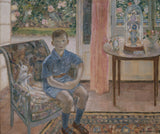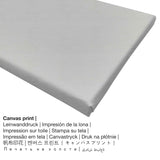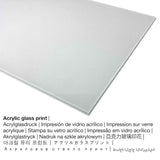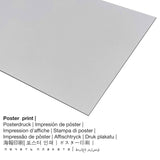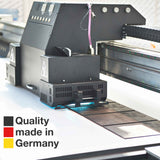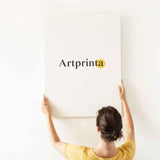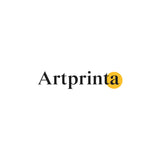Frederick Carl Frieseke, 1926 - Ntorobịa - mbipụta nka mara mma
Ụtụ gụnyere. Mbupu gbakọrọ na ndenye ọpụpụ.
Họrọ ihe ị ga-achọ inwe
Anyị na-enye ihe dị iche iche dị iche iche na nha maka ngwaahịa ọ bụla. Họrọ nha na ihe kacha amasị gị n'ime nhọrọ ndị a:
- Mbipụta kwaaji: A canvas print, not to be mistaken with an artwork painted on a canvas, is a digital replica printed on a UV direct printer. Hanging your canvas print: Canvas prints are relatively low in weight, which means that it is easy and straightforward to hang the Canvas print without the help of extra wall-mounts. Because of thata canvas print is suited for any kind of wall.
- Mbipụta nke aluminom: Aluminium Dibond prints are metal prints with an impressive depth, which creates a contemporary impression throuch a non-reflective surface. The bright and white parts of the work of art shimmer with a silk gloss but without any glare.
- Mbipụta akwụkwọ mmado (ihe kwaaji): A poster print is a printed sheet of canvas with a fine surface texture. It is optimally suited for framing the art replica with a special frame. Please note, that depending on the absolute size of the poster print we add a white margin 2-6cm around the artwork, which facilitates the framing with a custom frame.
- Bipụta na iko acrylic na-egbuke egbuke: An acrylic glass print, often referred to as a UV print on plexiglass, will turn the original work of art into beautiful wall decoration. Your artwork is being printed thanks to state-of-the-art UV print technology. It makes rich and impressive print colors. The great advantage of a plexiglass art print is that contrasts as well as smaller color details become exposed due to the precise gradation.
Nkwupụta iwu: We try our best to depict the art products as precisely as possible and to demonstrate them visually. Nevertheless, the tone of the print products, as well as the imprint may vary to a certain extent from the image on your device's monitor. Depending on your settings of your screen and the condition of the surface, colors may not be printed as realisitcally as the digital version shown here. In view of the fact that all our art reproductions are processed and printed manually, there might also be minor variations in the motif's exact position and the size.
Additional artwork information from Los Angeles County Museum of Art website (© Copyright - Los Angeles County Museum of Art - www.lacma.org)
This charming painting of a boy with his stuffed rabbit is a portrait of Preston Carter Harrison (born about 1921), son of Mr. and Mrs. William Preston Harrison. No doubt Preston Harrison chose Frieseke to paint the portrait on the advice of his artist-friends; indeed, Harrison records in a letter dated June 5, 1926, that Ernest Lawson (1873-1939) thought Frieseke the "greatest of all to paint youngsters." This sentiment was expressed to Harrison when the collector visited New York on his way to France. Frieseke painted the portrait a few weeks later at his summer home in Le-Mesnil-sur-Blangy. The Harrisons arrived there in late July, and by August 12 Harrison could write to Louise Upton at the museum that the portrait was completed. Harrison was quite satisfied with the finished painting, considering it not only a typical Frieseke but a painting worthy of being in the museum. It combined the best of Frieseke’s talents, being a figure painting to which natural light is essential. Young Carter sits politely on the edge of an elegant French chair, obviously posing for the artist and oblivious to the sunlight filtering into the room through the windows and door. The sun’s intense rays contrast with the soft interior light. The pastel palette used to describe the scene is unlike that of most late works by Frieseke, which are delicate but usually darker. In fact, although Frieseke completed the painting, it appears almost unfinished. Despite the delicate effect, the painting has a strong structure organized by the lines of the room and the placement of the furniture. The variety of decorative patterns within the composition do not confuse the legibility of the scene, and, in fact, the patterned objects -- upholstered chair, oriental rug, and garden flowers in the distance -- form a contrast with the figure of the quiet boy. Harrison entitled the painting Youth rather than identifying it as a portrait of his son to avoid the type of criticism that the portrait of Mrs. Harrison by ROBERT HENRI, 1925 (LACMA; q.v.), had received.
Ozi ngwaahịa nka zuru ezu
Youth was created by Frederick Carl Frieseke in 1926. The 90 arụ ọrụ nka dị afọ na nha: 50 3/16 x 60 1/16in (127,48 x 152,56 cm) ma were ihe osise ese Usoro mmanụ na kwaaji. Enwere ike ịhụ ya na nchịkọta nke Ebe ngosi nka nke Los Angeles County emi odude ke Los Angeles, California, Njikota Obodo Amerika. Obi dị anyị ụtọ ịkpọ nke a ngalaba ọha A na-etinye ọrụ nka na nkwanye ùgwù nke Ụlọ ihe ngosi nka nke Los Angeles County (www.lacma.org).Ọzọkwa, ọrụ nka nwere akara kredit a: . Ọzọkwa, nhazi nke mmepụta dijitalụ bụ odida obodo ya na oke nke 1.2: 1, nke pụtara na ogologo bụ 20% ogologo karịa obosara. The painter Frederick Carl Frieseke was an artist from United States, whose art style can mainly be classified as Impressionism. The North American artist lived for 65 afọ - a mụrụ n'afọ 1874 in Owosso, Shiawassee county, Michigan, United States and died in the year 1939.
Ozi ndabere na nka pụrụ iche
| Aha nke ọrụ nka: | "Ntorobia" |
| Nhazi: | sere |
| Okwu nche anwụ: | nkà nke oge a |
| Narị afọ nka: | 20th narị afọ |
| Afọ nka: | 1926 |
| Afọ nka: | ihe dị ka afọ 90 |
| Ihe osise izizi: | mmanụ na kwaaji |
| Nha izizi (ọrụ nka): | 50 3/16 x 60 1/16in (127,48 x 152,56 cm) |
| Ụlọ ihe ngosi nka / ebe: | Ebe ngosi nka nke Los Angeles County |
| Ebe ngosi nka: | Los Angeles, California, Njikota Obodo Amerika |
| E Nwere na: | www.lacma.org |
| Ụdị ikike nka: | ngalaba ọha |
| Site n'aka: | Ụlọ ihe ngosi nka nke Los Angeles County (www.lacma.org) |
Banyere ihe a
| Nkewa edemede: | mmepụta nka |
| Usoro mmeputakwa: | dijitalụ mmeputakwa |
| Usoro mmepụta: | mbipụta dijitalụ |
| Nlụpụta: | emere na Germany |
| Stockdị ngwaahịa: | mmepụta ihe na-achọ |
| Eji ngwaahịa a chọrọ: | imewe ụlọ, mgbidi gallery |
| Ndozi onyonyo: | usoro odida obodo |
| Oke akụkụ onyonyo: | ogologo ruo obosara 1.2: 1 |
| Ntụgharị asụsụ oke onyonyo: | ogologo bụ 20% ogologo karịa obosara |
| Akwa ngwaahịa dị: | akwụkwọ mmado (akwụkwọ kwaaji), mbipụta enyo acrylic (nke nwere ezigbo mkpuchi iko), mbipụta ọla (aluminium dibond), mbipụta kwaaji |
| Nhọrọ nke Canvas Mbipụta (akwa akwa na etiti ihe ndọtị): | 60x50cm - 24x20", 120x100cm - 47x39" |
| Mbipụta iko acrylic (nwere ezigbo mkpuchi iko) nhọrọ nha: | 60x50cm - 24x20", 120x100cm - 47x39" |
| Mbipụta akwụkwọ mmado (akwụkwọ kwaaji): | 60x50cm - 24x20", 120x100cm - 47x39" |
| Nhọrọ nha nke mbipụta aluminom (aluminium dibond material) | 60x50cm - 24x20", 120x100cm - 47x39" |
| Nhazi mbipụta nka: | adịghị |
Banyere onye na-ese ihe
| Ihe nkiri: | Frederick Carl Frieseke |
| Aha ndị ọzọ: | friesecke f.c., f.c. frieseke, Frieseke Frederick Carl, Frederick C. Frieseke, Frederick Carl Frieseke, friesecke, Frieseke, Frieseke Frederick C. |
| Gender: | nwoke |
| Obodo onye nka: | American |
| Ọrụ nke onye na-ese ihe: | onye na-ese ihe |
| Mba onye si: | United States |
| Otu nka: | omenkà nke oge a |
| Ụdị nka: | Mmetụta |
| Oge ndu: | 65 afọ |
| Afọ amụrụ: | 1874 |
| Ebe omuma: | Owosso, Shiawassee County, Michigan, Njikota Obodo Amerika |
| Afọ nwụrụ: | 1939 |
| Nwuru na (ebe): | New York City, New York State, Njikota Obodo Amerika |
© nwebisiinka, Artprinta.com

